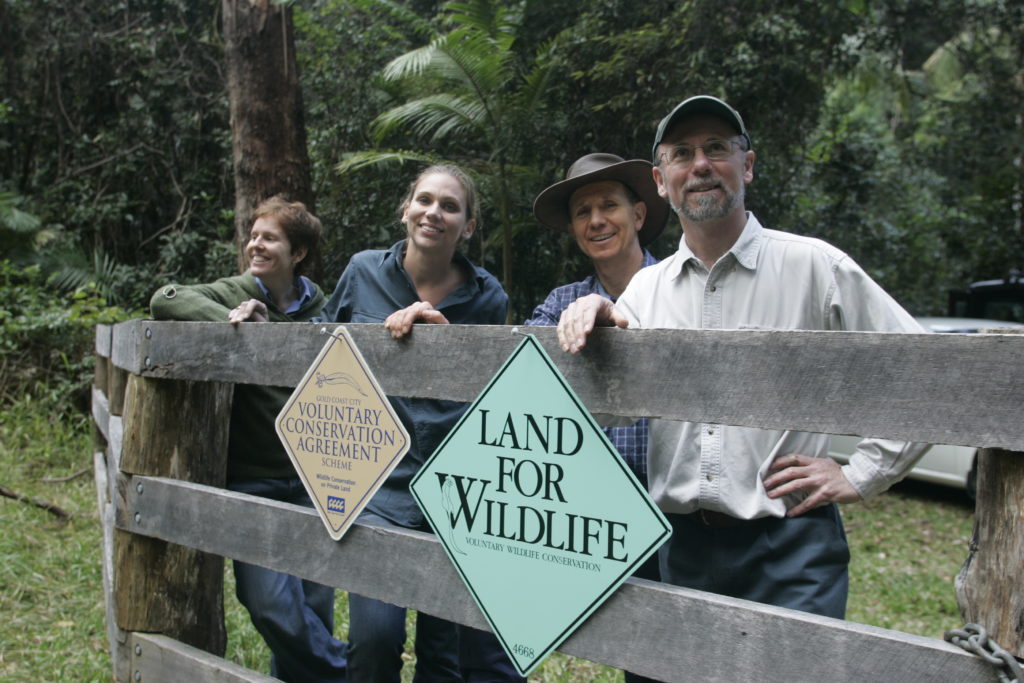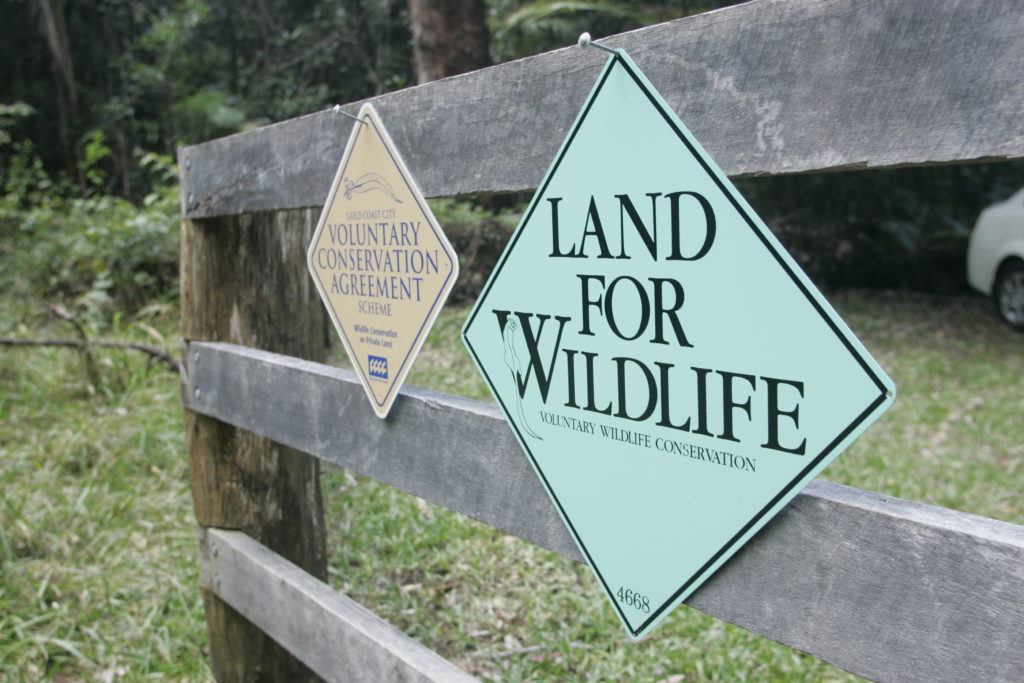About the middle of 1998 three newly appointed Land for Wildlife Officers (I was one of them) and their regional coordinator met for the first time at Woodend Nature Reserve in Ipswich. The purpose of this meeting was for us to get acquainted and to chart operating guidelines for the new program. We had just three years of Federal Government funding through the Natural Heritage Trust so we knew we had to hit the ground running and see if Land for Wildlife could make a significant contribution to biodiversity conservation and if it would be popular with landholders in SEQ.

Right to Left: Darryl Larsen, Wal Mayr, Lexie Webster and Deborah Metters on Wal’s Land for Wildlife property in 2009.
Land for Wildlife already had a proven track record in Victoria so the essential features of the scheme could be readily implemented. However it did need a little tweaking due to the fact that in SEQ Local Governments rather than the State Government would be delivering the scheme and also that the target properties here were a little different from those in Victoria e.g. many peri-urban properties here and fewer large grazing properties.
I recall that we discussed policy and operational matters e.g. setting a minimum property size to qualify for registration and defining consistent service delivery standards. We also discussed some technical matters e.g. should we adopt the broad vegetation classification used in Victoria for Land for Wildlife assessments or should we opt for the Regional Ecosystem (RE) classification as recently adopted in Queensland? Thankfully we chose the latter. Continuing in that vein we have aimed in the newsletter and elsewhere to steer a course between unnecessary scientific jargon and oversimplifying or avoiding scientific concepts altogether. Managing a property for biodiversity conservation can raise some challenging questions so we wanted our members to be well equipped with a solid, scientifically- based understanding of land management and ecosystem processes.
We then embarked on a frantic three years of recruitment with some officers spread over four Local Government areas, in my case, Gold Coast, Beaudesert, Logan and Redland! Our future was uncertain – what would happen when the Federal Government funding ran out at the end of three years? Thankfully, the participating Councils valued the program and stepped up to take full ownership in 2001. At this time, many new officers were appointed across the region, new Councils came on board and I took up a full time position with City of Gold Coast. Some additional administrative coordination was provided by Queensland Parks and Wildlife Service and then by Greening Australia.
n 2004, regional coordination of Land for Wildlife was taken over by Natural Resource Management Southeast Queensland (NRMSEQ) and a new regional coordinator, Deborah Metters was appointed. This brings us to the present day except that NRMSEQ has had a name change to SEQ Catchments. Deborah, of course, remains in the position of coordinator and newsletter editor (having taken the newsletter from a rather amateurish state to a highly professional and exciting looking publication). SEQ Catchments has proved to be an ideal host for program coordination as it is able to take a regional perspective on a range of private land conservation initiatives.

The period from 2004 to the present has seen Land for Wildlife expand and mature. It is now strongly integrated with a range of other Local Government programs like voluntary conservation agreements, conservation covenants, environmental grants and urban wildlife schemes as well as the traditional services like pest management and natural areas management. So looking back, what have been some of the dramatic changes in the day to day workings of Land for Wildlife?
First is the greatly increased level of support for landholders. While the type of support varies across Councils it typically includes workshops and field days, detailed information specific to the property, property revisits to provide ongoing advice, grants to assist in on-ground conservation activities and ecological monitoring. Add to that incentives ranging from field guides to free plants, restoration tool kits and the loan of infra- red monitoring cameras.
Second is the improvement in resources to assist with property planning including high resolution aerial photography and satellite imagery and more detailed and accurate vegetation mapping. It’s hard to imagine now that in the early years of the program I laboriously worked out REs from first principles using paper 1:100,000 geology and topographic maps and my list of plant species recorded on site, whereas now the information is instantly available at the click of a mouse.
Third is the amazing development of electronic devices. In 1998 we had no digital cameras, no tablets, no laptops and mobile phones were primitive affairs. The first digital camera we purchased for work required a disk to be inserted and could take a maximum of five low resolution photos before a fresh disk needed to be inserted. But we thought it was amazing, mainly because it was so easy to email an image instead of sending it by post!
I’ve enjoyed my time with Land for Wildlife, seeing the scheme develop into something which is unique in the world and which we can all be proud of. I feel privileged to have been acquainted with many amazing properties and their dedicated owners. But after 17 years it’s time for a change and I’m looking forward to new landscapes, projects and challenges.
I feel confident that I’m leaving the City of Gold Coast scheme in very capable hands and that Land for Wildlife will continue to develop and innovate to help meet the pressing challenge of biodiversity loss – so good luck! And hopefully, see you around.
Article by Darryl Larsen, Land for Wildlife Officer (retired), City of Gold Coast

Hello, my name is Candice; I was wondering whether I could have permission to use the second photo on this page (the photo of just the signs on the fence)? I coordinate the newsletter for a group called the Biodiversity Council and I’m looking for a good image to accompany an article about privately protected areas 🙂 It’s just a short paragraph that links to a research article. Thanks!
Hi Candice. If you wish to request an image, please email the newsletter Editor at deborah@seqlfw.com.au